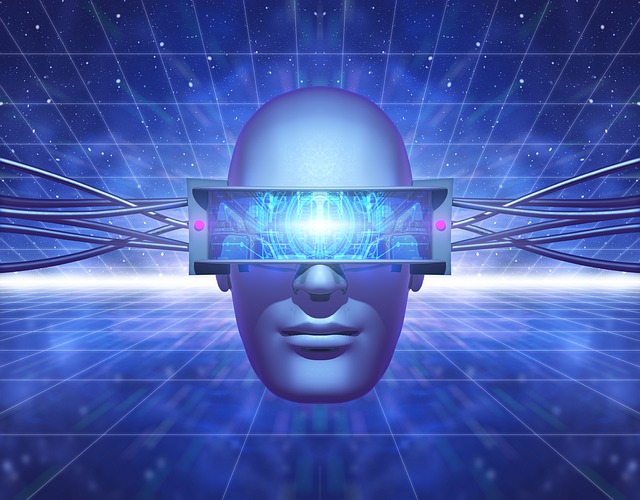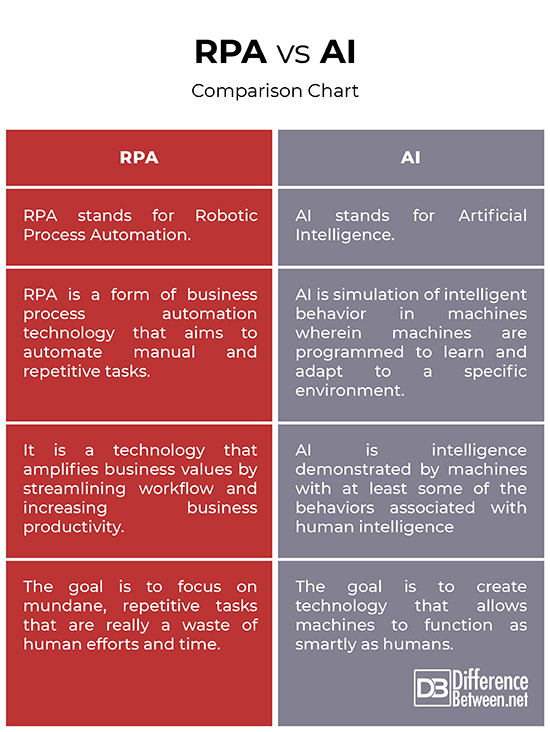Difference Between RPA and AI
AI and RPA are two complementary technologies that are very different in their goals. The ever expanding world of artificial intelligence comprises of many different technologies and terms, which naturally lead to some sort of confusion. One such term which is often mentioned in conjunction is robotic process automation, RPA. AI is an umbrella term for technologies like RPA, which describes the use of bots to automate business operations by mimicking human actions on computers. So, let’s take a look at both of them briefly and try to understand the difference between the two.

What is RPA?
RPA, short for Robotic Process Automation, is a rapidly growing technology that aims to automate business operations by mimicking human actions on computers. RPA is the use of computer software robots, or bots to perform a set of specified actions or tasks and end-to-end processes with utmost precision and speed. It is a form of business process automation technology governed by business logic and structured inputs that aims to automate manual and repetitive tasks. Imagine going to work and instead of having your team to create and pull data from systems manually, you had the reports already being processed and analyzed. This is one of the examples of how RPA can help streamline workflow and increase business productivity and efficiency. Automating business operations and processes that require zero human interaction is the purpose of RPA. It mimics the actions of a user at the user interface level to execute a business process that’s really a waste of human efforts.

What AI can do?
AI, short for Artificial Intelligence, is intelligence demonstrated by machines with at least some of the behaviors associated with human intelligence such as planning, learning, etc. The field of AI has been around since the birth of computers in and around the 1940s and 1950s. In its early development, the idea behind AI was to get computers to do things that would be regarded as intelligent if done by humans. So, the inspiration came from the idea of getting computers to copy humans in some or all aspects of their behavior. As the time passed, the notion of AI has changed and it was no longer limited to merely mimicking human intelligence – now it has intelligence of its own. However, the central notion of intelligence in AI remains so ill defined. AI is basically the simulation of intelligent behavior in computers. It is a suite of technologies where machines are programmed to learn and adapt to a specific environment. Today, AI is everywhere and one way or another, we interact with AI on a daily basis.
Difference between RPA and AI
Definition
– Robotic Process Automation or RPA is a rapidly growing software technology that involves using bots to automate mundane, repetitive manual tasks and end-to-end processes which otherwise, would be a waste of human efforts. It is a process of automating business operations and processes with the help of software robots in order to minimize human involvement.
Artificial Intelligence or AI is simulation of intelligent behavior in machines wherein machines are programmed to learn and adapt to a specific environment. It is a far-reaching branch of computer science that involves making machines capable enough to perform complex tasks that would require human intelligence.
Goal
– RPA is a form of business process automation technology governed by business logic and structured inputs which aims to automate manual and repetitive tasks. RPA is a technology that amplifies business values by streamlining workflow and increasing business productivity. The goal is to focus on mundane, repetitive tasks that are really a waste of human efforts and time.
AI is an umbrella term for multiple technologies, one of which is AI – it enables RPA to be more resilient and productive. The goal is to create technology that allows machines and computers to function as intelligent as humans.
Use Cases
– Businesses worldwide have already started implanting robotic process automation in their various business processes and operations, particularly in HR sections. It enables businesses to create true virtual workforces that drive business agility and efficiency. Some real world use cases for RPA include sales analytics, store planning, product categorization, invoice processing, sales orders, payroll management, processing refunds, etc.
Artificial Intelligence, on the other hand, is everywhere and one way or another, we interact with AI on a daily basis. Some real-world applications of AI include digital assistants, social media, self-driving cars, image recognition, machine learning, predictive maintenance, information technology management, cyber security, and so on.
RPA vs. AI: Comparison Chart

Summary of RPA vs. AI
Both are complementary technologies, rather than contradictory which augment which other In fact, AI is an umbrella term for many different technologies, one of which is Robotic Process Automation. AI enables RPA to be more resilient and productive. RPA is like your digital workforce – you show the bots what to do and they’ll do all the heavy lifting. They can interact with any system or application like humans do. They learn from humans and they have one goal – to perform the tasks humans assign and control. The idea is to program bots to perform mundane, repetitive tasks that are really a waste of human efforts and time. The idea behind AI is to get computers to copy humans in some or all aspects of their behavior.
- Difference Between Caucus and Primary - June 18, 2024
- Difference Between PPO and POS - May 30, 2024
- Difference Between RFID and NFC - May 28, 2024
Search DifferenceBetween.net :
Leave a Response
References :
[0]Taulli, Tom. The Robotic Process Automation Handbook: A Guide to Implementing RPA Systems. New York, United States: Apress, 2020. Print
[1]Taulli, Tom. The Robotic Process Automation Handbook: A Guide to Implementing RPA Systems. New York, United States: Apress, 2020. Print
[2]Tripathi, Alok Mani. Learning Robotic Process Automation: Create Software Robots And Automate Business Processes With The Leading RPA Tool – Uipath. Birmingham, United Kingdom: Packt Publishing, 2018. Print
[3]Wibbenmeyer, Kelly. The Simple Implementation Guide to Robotic Process Automation (RPA): How to Best Implement RPA in an Organization. Indiana, United States: iUniverse, 2018. Print
[4]Mitchell, Melanie. Artificial Intelligence: A Guide for Thinking Humans. New York, United States: Farrar, Straus and Giroux, 2019. Print
[5]Warwick, Kevin. Artificial Intelligence: The Basics. Abingdon, United Kingdom: Routledge, 2013. Print
[6]Image credit: https://cdn.pixabay.com/photo/2020/02/13/15/37/ai-4846063_1280.jpg
[7]Image credit: https://www.needpix.com/photo/1845382/robot-automation-factory-industry-machine-equipment-engineering-work-robotic
